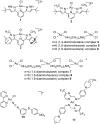Gold(III) Complexes: An Overview on Their Kinetics, Interactions With DNA/BSA, Cytotoxic Activity, and Computational Calculations
- PMID: 32509724
- PMCID: PMC7251155
- DOI: 10.3389/fchem.2020.00379
Gold(III) Complexes: An Overview on Their Kinetics, Interactions With DNA/BSA, Cytotoxic Activity, and Computational Calculations
Abstract
In the last few years, metallodrugs play a key role in the development of medicinal chemistry. The choice of metal ion, its oxidation state and stability, and the choice of inert and labile ligands are just some of the very important facts which must be considered before starting the synthesis of complexes with utilization in medicinal purpose. As a result, a lot of compounds of different transition metal ions found application for diagnostic and therapeutic purpose. Beside all, gold compounds have attracted particular attention. It is well-known that gold compounds could be used for the treatment of cancer, HIV, rheumatoid arthritis (chrysotherapy), and other diseases. This metal ion has unoccupied d-sublevels and possibility to form compounds with different oxidation states, from -1 to +5. However, gold(I) and gold(III) complexes are dominant in chemistry and medicine. Especially, gold(III) complexes are of great interest due to their structural similarity with cisplatin. Accordingly, this review summarizes the chemistry of some mononuclear and polynuclear gold(III) complexes. Special attention is given to gold(III) complexes with nitrogen-donor inert ligands (aliphatic or aromatic that have a possibility to stabilize complex) and their kinetic behavior toward different biologically relevant nucleophiles, mechanism of interaction with DNA/bovine serum albumin (BSA), cytotoxic activity, as well as computational calculations.
Keywords: DNA; bovine serum albumin (BSA); computational calculations; cytotoxicity; density functional theory (DFT) calculations; gold(III) complexes; kinetics.
Copyright © 2020 Radisavljević and Petrović.
Figures
Similar articles
-
Synthesis, characterization, DFT study, DNA/BSA-binding affinity, and cytotoxicity of some dinuclear and trinuclear gold(III) complexes.J Biol Inorg Chem. 2019 Oct;24(7):1057-1076. doi: 10.1007/s00775-019-01716-8. Epub 2019 Sep 5. J Biol Inorg Chem. 2019. PMID: 31489480
-
In vitro antitumor activity, metal uptake and reactivity with ascorbic acid and BSA of some gold(III) complexes with N,N'-ethylenediamine bidentate ester ligands.J Inorg Biochem. 2017 Jul;172:55-66. doi: 10.1016/j.jinorgbio.2017.04.001. Epub 2017 Apr 4. J Inorg Biochem. 2017. PMID: 28433833
-
Synthesis, characterization and theoretical calculations of (1,2-diaminocyclohexane)(1,3-diaminopropane)gold(III) chloride complexes: in vitro cytotoxic evaluations against human cancer cell lines.Biometals. 2015 Oct;28(5):827-44. doi: 10.1007/s10534-015-9869-1. Epub 2015 Jun 23. Biometals. 2015. PMID: 26099502
-
Beyond platinums: gold complexes as anticancer agents.Anticancer Res. 2014 Jan;34(1):487-92. Anticancer Res. 2014. PMID: 24403506 Review.
-
Cyclometalated Complexes of Platinum and Gold with Biological Properties: State-of-the-Art and Future Perspectives.Curr Med Chem. 2018 Feb 12;25(4):437-461. doi: 10.2174/0929867324666170529125229. Curr Med Chem. 2018. PMID: 28554319 Review.
Cited by
-
Antitumoral and Antimicrobial Activities of Block Copolymer Micelles Containing Gold Bisdithiolate Complexes.Pharmaceutics. 2023 Feb 8;15(2):564. doi: 10.3390/pharmaceutics15020564. Pharmaceutics. 2023. PMID: 36839886 Free PMC article.
-
A Cytotoxic Indazole-based Gold(III) Carboxamide Pincer Complex Targeting DNA Through Dual Binding Modes of Groove Binding and Alkylation.Chemistry. 2025 May 14;31(27):e202404345. doi: 10.1002/chem.202404345. Epub 2025 Apr 16. Chemistry. 2025. PMID: 40162557 Free PMC article.
-
Computational Studies of Au(I) and Au(III) Anticancer MetalLodrugs: A Survey.Molecules. 2021 Dec 15;26(24):7600. doi: 10.3390/molecules26247600. Molecules. 2021. PMID: 34946684 Free PMC article. Review.
-
Novel Papaverine Metal Complexes with Potential Anticancer Activities.Molecules. 2020 Nov 20;25(22):5447. doi: 10.3390/molecules25225447. Molecules. 2020. PMID: 33233775 Free PMC article.
-
[AuIII(N^N)Br2](PF6): A Class of Antibacterial and Antibiofilm Complexes (N^N = 2,2'-Bipyridine and 1,10-Phenanthroline Derivatives).Inorg Chem. 2023 Feb 13;62(6):2924-2933. doi: 10.1021/acs.inorgchem.2c04410. Epub 2023 Feb 2. Inorg Chem. 2023. PMID: 36728360 Free PMC article.
References
-
- Abdnoor Z. M., Albdali A. J. (2019). Synthesis, characterization, and anticancer activity of some azole-heterocyclic complexes with gold(III), palladium(II), nickel(II), and copper(II) metal ions. J. Chin. Chem. Soc. 66, 1474–1483. 10.1002/jccs.201900010 - DOI
-
- Alafeefy A. M., Ashour A. E., Prasad O., Sinha L., Pathak S., Alasmari F. A., et al. (2015). Development of certain novel N-(2-(2-(2-oxindolin-3-ylidene)hydrazinecarbonyl)phenyl)-benzamides and 3-(2-oxoindolin-3-ylideneamino)-2-substituted quinazoli-4(3H)-ones as CFM-1 analogs: design, synthesis, QSAR analysis and anticancer activity. Eur. J. Med. Chem. 92, 191–201. 10.1016/j.ejmech.2014.12.048 - DOI - PubMed
-
- Altaf M., Monim-Ul-Mehboob M., Kawde A. N., Corona G., Larcher R., Ogasawara M., et al. . (2017). New bipyridine gold(III) dithiocarbamate-containing complexes exerted a potent anticancer activity against cisplatin-resistant cancer cells independent of p53 status. Oncotarget 8, 490–505. 10.18632/oncotarget.13448 - DOI - PMC - PubMed
-
- Andrew F., Ajibade P. (2018). Synthesis, characterization and anticancer studies of bis-(N-methyl-1-phenyldithiocarbamato) Cu(II), Zn(II), and Pt(II) complexes: single crystal X-ray structure of the copper complex. J. Coord. Chem. 71, 2776–2786. 10.1080/00958972.2018.1489537 - DOI
Publication types
LinkOut - more resources
Full Text Sources
Research Materials


